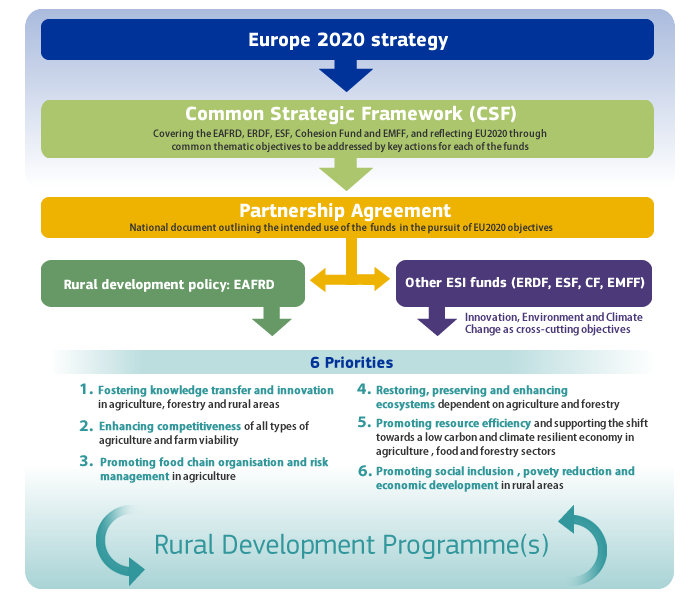The EU's Rural Development policy supports rural areas to meet the wide range of economic, environmental and social challenges of the 21st century. It aims to achieve the following strategic objectives:
See relevant Rural Development policy legislation.
Rural Development policy is referred to as the 'second pillar' of the EU's Common Agricultural Policy (CAP), complementing the system of direct payments to farmers and measures to manage agricultural markets ('first pillar').
Common Agricultural Policy (CAP) |
CAP's first pillar supports farmers' incomes – financed entirely from the European Agricultural Guarantee Fund (EAGF)
CAP's second pillar supports rural areas – co-financed from the European Agricultural Fund for Rural Development (EAFRD) and national contributions
The broader Rural Development policy objectives are further articulated through six priorities, providing a basis for implementing the policy.
Priority 1: Knowledge Transfer and Innovation
Priority 2: Farm Viability and Competitiveness
Priority 3: Food Chain Organisation and Risk Management
Priority 4: Restoring, Preserving and Enhancing Ecosystems
Priority 5: Resource-efficient, Climate-resilient Economy
Priority 6: Social Inclusion and Economic Development
See priority summaries, providing aggregated information on the expected achievements and results, planned targets and interventions.
The six policy priorities are further elaborated through 18 specific areas of intervention – Focus Areas – jointly providing the basis for rolling out support under the EAFRD.
See Focus Area summaries, providing aggregated information on the expected achievements and results, planned targets and interventions.
Within this framework, Rural Development policy is implemented through Rural Development Programmes (RDPs) in each EU Member State. RDPs are documents drawn up by countries and regions, setting out strategic approaches and actions to meet the needs of the specific geographical area they cover.
In the 2014-2020 programming period, there are 118 national and regional RDPs funded through the EAFRD and national contributions. In the current seven-year period, approximately EUR 100 billion through the EAFRD and EUR 61 billion of public funding in the Member States is being spent on rural development.
See RDP summaries, overviewing each national and regional RDP in terms of planned expenditure and 2023 targets.
Rural development funding through the EAFRD is part of a broader framework of European Structural and Investment Funds (ESI Funds) – the EU's main investment policy tool with an overall budget of EUR 454 billion in the 2014-2020 programming period.
The ESI Funds include Rural Development (EAFRD), Fisheries (EMFF), Regional Development (ERDF), Cohesion (CF) and Social (ESF). At the European level, the ESI Funds are formally governed by a Common Provisions Regulation, a set of basic legal rules defining the shared strategic approach to the Funds' use. Additionally, they are guided and coordinated under a Common Strategic Framework (Annex I of the Regulation).
This European-level coordination ensures that the ESI Funds contribute to the Europe 2020 strategy for smart, sustainable and inclusive growth, setting ambitious targets in the areas of employment; research and development; climate change and energy; education; and poverty and social exclusion.
The five ESI Funds are managed nationally, by each EU Member State, on the basis of Partnership Agreements negotiated and signed with the European Commission. They are strategic plans outlining each country's goals and investment priorities and setting out the use of ESI funding.
See Partnership Agreement summaries, overviewing the interaction between ESI Funds and including a special focus on how the EAFRD budget is distributed among thematic objectives in each EU Member State.

See also Rural Development policy framework in the 2007-2013 programming period.
€650 billion of investment financing (almost twice the proposed CAP budget for post 2020) has been proposed to become available during the 20121-2027 period through the InvestEU Programme - and rural Europe is eligible for this investment finance.
InvestEU builds on the significant success of the European Fund for Strategic Investments, which has already exceeded its target to support €500 billion of investment by 2020.
InvestEU is part of the EU's economic policy toolkit and it is designed to distribute repayble finance. It encourages private sector financing (e.g. from banks, pension funds, equity providers, etc.) to invest their private funds into projects that create public policy outcomes.
InvestEU does this by providing a publicly-funded guarantee to its investors. The guarantee helps to reduce risk for investors and allows their funds to be invested in projects in which they would not normally be.
InvestEU will also help to raise awareness among investors about types of profitable projects that have public policy outcomes. It can invest in profit-generating projects (including those creating cost-savings) covering four broad policy areas: sustainable infrastructure; research, innovation and digitisation; small and medium businesses; and social investment and skills.
All of these policy areas remain highly relevant to the long-term development of rural Europe. Agri-food sectors, rural infrastructure and other priorities for inward investment in rural Europe can benefit from InvestEU.
No specific allocations are ring-fenced for rural projects within the current InvestEU model and the finance is to be offered on a first-come-first-served basis.
A number of different opportunities are available to help projects and investors to make easy use of InvestEU. For instance: